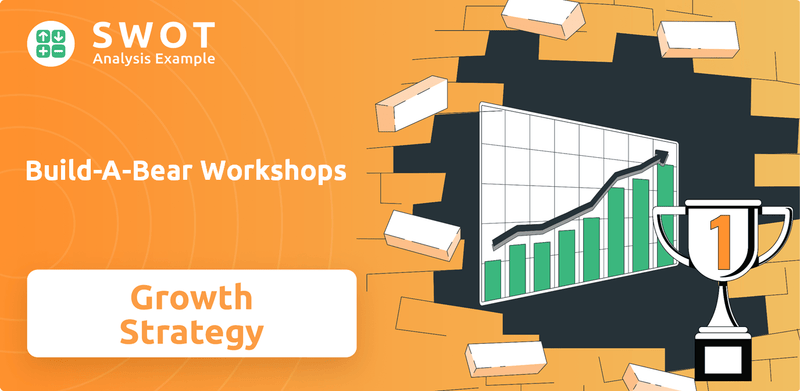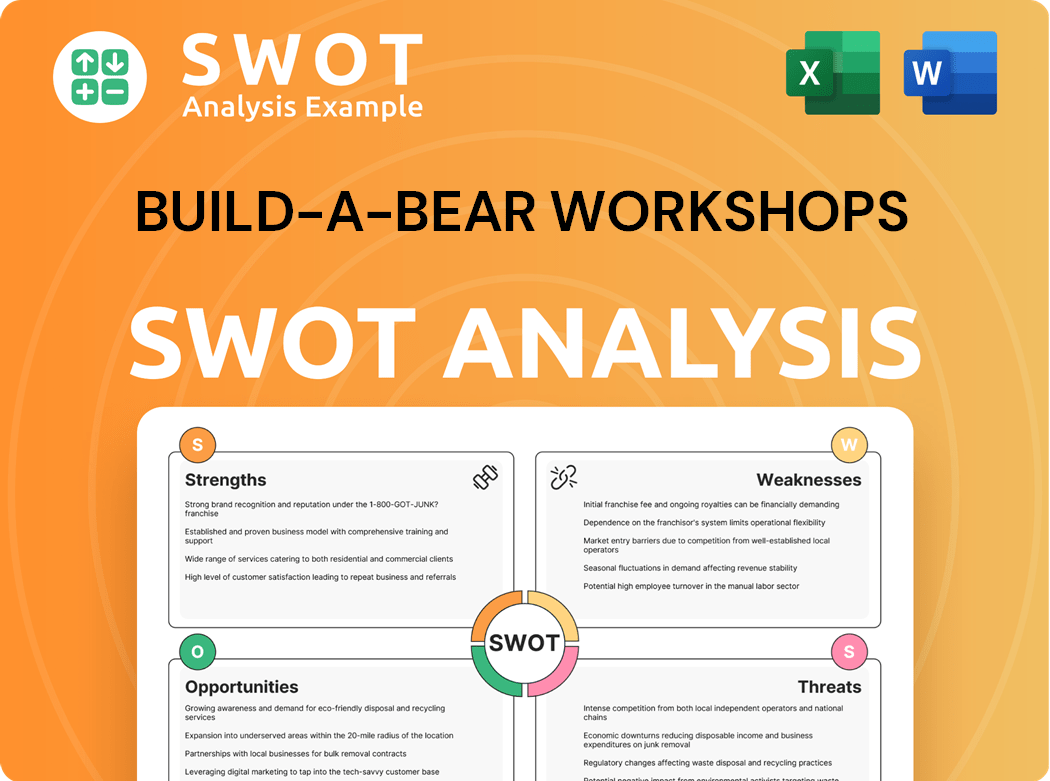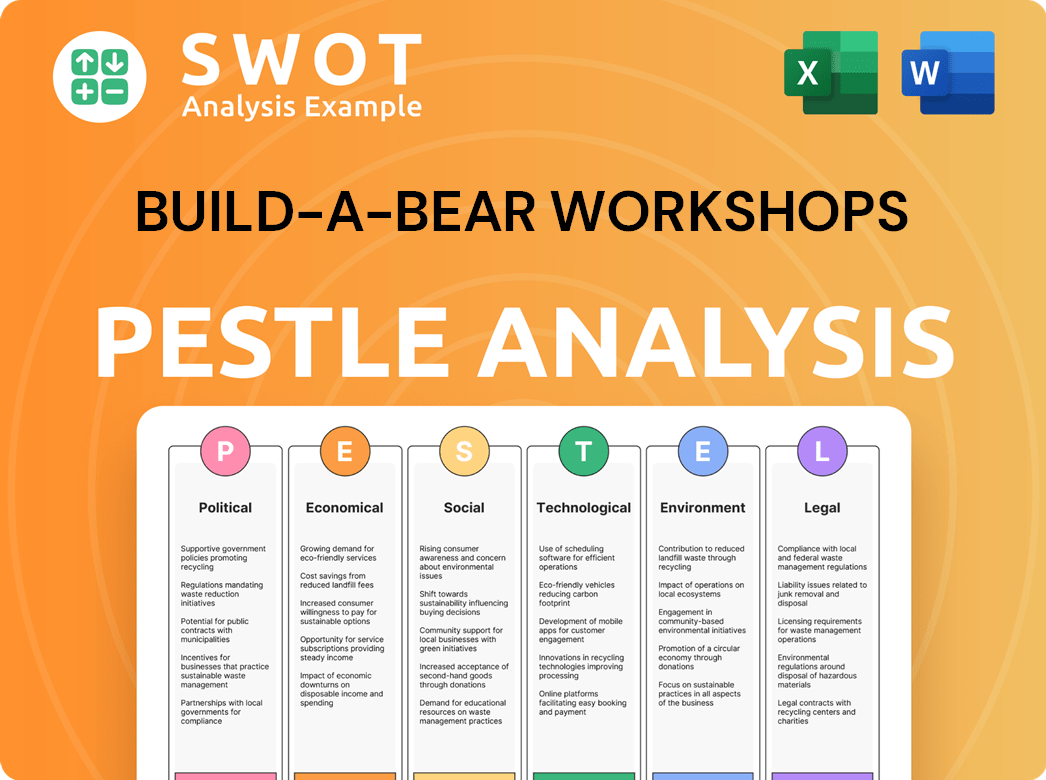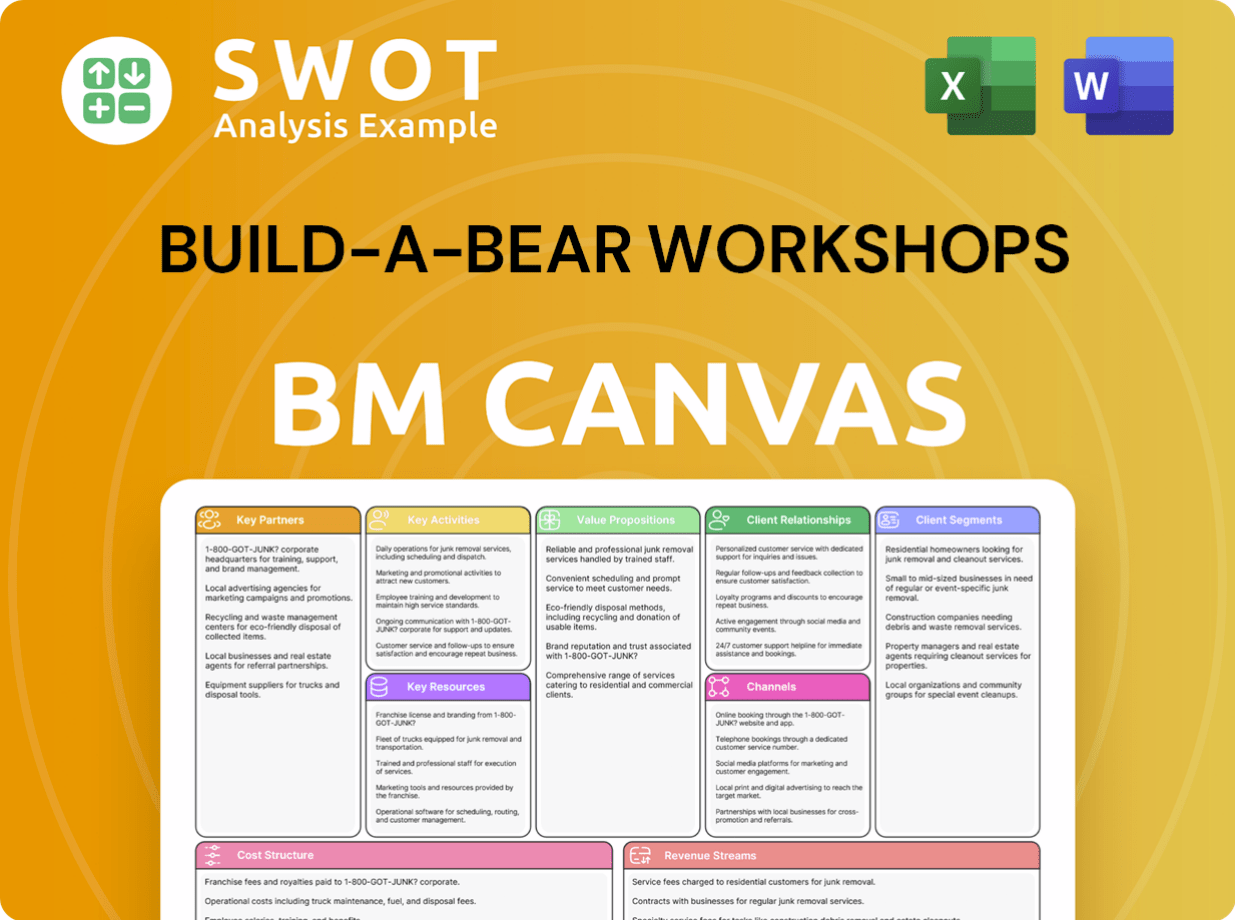Build-A-Bear Workshops Bundle
Can Build-A-Bear Workshop Continue Its Winning Streak?
Build-A-Bear Workshop, Inc. (NYSE: BBW) revolutionized retail with its interactive, personalized stuffed animal experience, capturing hearts and market share since 1997. From its iconic 'heart ceremony' to a global presence exceeding 600 locations, the company has consistently innovated. With record revenues in fiscal 2024, the focus now shifts to its Build-A-Bear Workshops SWOT Analysis and future growth prospects.

This analysis delves into Build-A-Bear's dynamic growth strategy, examining its business model and future prospects. We'll explore the company's expansion strategy, market share analysis, and financial performance, providing insights for investors and business strategists. Understanding Build-A-Bear's competitive landscape and customer engagement strategies is critical to assessing its long-term potential.
How Is Build-A-Bear Workshops Expanding Its Reach?
The expansion initiatives of Build-A-Bear Workshop are central to its growth strategy, focusing on both geographic reach and diversification of revenue streams. The company's approach includes a blend of corporate-owned, partner-operated, and franchised locations, with a significant emphasis on an 'asset-light' model. This strategy allows for faster growth and reduced capital expenditure, enabling the company to capitalize on opportunities in various markets.
In fiscal year 2024, Build-A-Bear opened a total of 64 new stores, with a substantial portion, 72%, being partner-operated. This highlights the company's commitment to leveraging partnerships for expansion. International growth is a key component, with roughly half of the new stores in fiscal 2024 located outside of the United States, extending its presence to over 25 countries. The company anticipates opening at least 50 new locations globally in fiscal 2025, maintaining a similar balance between store types.
The company's expansion strategy is designed to enhance its market position and increase revenue through a variety of channels. This includes new store openings, product line diversification, and leveraging its brand through outbound licensing agreements and content creation. For a deeper dive into the marketing approaches, consider exploring the Marketing Strategy of Build-A-Bear Workshops.
Build-A-Bear is actively expanding its global footprint, with significant growth in countries like Italy, where 13 partner-operated locations have been established. New stores have also opened in Mexico, Norway, Colombia, Fiji, Kuwait, and the UAE. The company is also targeting key tourist destinations, with plans to introduce a new, multi-level retail experience at ICON Park in Orlando, Florida, scheduled for 2026.
Beyond new store openings, Build-A-Bear is diversifying its product categories and business models. This includes the launch of new product lines, such as the Mini Beans collection in early 2024, offering hand-held sized furry friends priced under $10. The company is also expanding its commercial segment, which primarily represents wholesale sales to partner operators, expecting this segment to grow at a higher rate than company-owned stores in the future.
The company's strategy also involves leveraging its brand through outbound licensing agreements for non-plush consumer categories. Build-A-Bear is also focused on creating engaging content via Build-A-Bear Entertainment, further extending its brand presence and appeal to a broader audience. These initiatives aim to enhance customer engagement and diversify revenue streams.
Build-A-Bear's expansion strategy is supported by its financial performance and operational efficiency. The company's focus on partner-operated stores and international growth allows for efficient capital allocation and faster market penetration. The opening of at least 50 new locations globally in fiscal 2025 demonstrates the company's commitment to sustained growth. The diversification into new product lines and licensing agreements is expected to further enhance revenue and brand value.
Build-A-Bear's expansion strategy is multifaceted, incorporating various approaches to achieve sustainable growth. This includes a focus on partner-operated stores, international expansion, product diversification, and brand leveraging.
- Partner-operated and franchised locations to reduce capital expenditure.
- International expansion to extend its global presence.
- Diversification of product lines and business models.
- Leveraging the brand through licensing and content creation.
Build-A-Bear Workshops SWOT Analysis
- Complete SWOT Breakdown
- Fully Customizable
- Editable in Excel & Word
- Professional Formatting
- Investor-Ready Format

How Does Build-A-Bear Workshops Invest in Innovation?
The innovation and technology strategy of Build-A-Bear Workshop is crucial for its Growth Strategy and future success. The company focuses on enhancing customer experience through digital transformation, including e-commerce and third-party marketplaces, complementing its physical stores. This approach allows Build-A-Bear to reach a wider audience and provide engaging purchasing experiences.
Build-A-Bear is expanding its offerings to cater to a broader audience, recognizing the 'multi-generational adulting appeal.' This segment accounts for approximately 40% of sales, driven by collectibles, trends, licensing, and gifting. The launch of new collections, such as the Mini Beans in early 2024, demonstrates a commitment to diverse products at various price points.
The company's commitment to innovation is further supported by ongoing investments in 'products, infrastructure, content, and people.' This signifies a broader effort to support long-term growth objectives. Collaborations with 'best-in-class licenses' for plush toys also play a key role, aligning with popular culture and fostering emotional connections with consumers.
Build-A-Bear has evolved its online presence to include the 'Bear-Builder' and 'Bear Builder 3D Workshop,' providing engaging digital purchasing experiences.
The introduction of new product lines, like the Mini Beans in early 2024, shows the company's commitment to diverse offerings.
Recognizing its 'multi-generational adulting appeal' which accounts for 40% of sales, Build-A-Bear focuses on collectibles, trends, licensing, and gifting.
Collaborations with 'best-in-class licenses' help to align with popular culture.
Ongoing investment in 'products, infrastructure, content, and people' supports long-term growth.
The company's e-commerce sites and third-party marketplace presence complement its physical store experience.
Build-A-Bear Workshop's approach to innovation involves digital enhancements, product diversification, and strategic partnerships. These strategies are designed to improve customer engagement and drive sales. For a deeper dive into the company's financial performance and strategic direction, further insights can be found in a comprehensive Build-A-Bear Workshop analysis.
- Digital Platforms: Enhancing online presence with interactive features like the 'Bear-Builder' and 'Bear Builder 3D Workshop.'
- Product Development: Launching new collections, such as Mini Beans, to cater to diverse customer preferences.
- Licensing Agreements: Collaborating with popular brands to create licensed plush toys.
- Marketplace Presence: Utilizing e-commerce sites and third-party marketplaces to expand reach.
Build-A-Bear Workshops PESTLE Analysis
- Covers All 6 PESTLE Categories
- No Research Needed – Save Hours of Work
- Built by Experts, Trusted by Consultants
- Instant Download, Ready to Use
- 100% Editable, Fully Customizable

What Is Build-A-Bear Workshops’s Growth Forecast?
The financial outlook for Build-A-Bear Workshop is promising, with the company demonstrating strong financial performance. The company achieved its fourth consecutive year of record revenues and pretax income in fiscal 2024, showcasing its robust business model and effective growth strategy. This consistent performance highlights the company's ability to adapt and thrive in the competitive retail landscape.
For fiscal 2024, Build-A-Bear Workshop reported total revenues of $496.4 million. The company's financial health is further supported by its strategic initiatives and operational efficiencies. This strong financial foundation positions Build-A-Bear well for future expansion and continued success in the market. A deeper dive into the Competitors Landscape of Build-A-Bear Workshops can provide further context.
Looking ahead to fiscal 2025, Build-A-Bear anticipates mid-single-digit revenue growth, with projected revenues of $519 million, representing a 5% increase from fiscal 2024. Pretax income for fiscal 2025 is expected to range from a low-single-digit decline to low-single-digit growth. This outlook is influenced by over $10 million in additional costs, including tariffs and increased medical and labor expenses. Despite these headwinds, the company's core operations are expected to support continued margin expansion in fiscal 2025.
Build-A-Bear projects earnings per share (EPS) of $4.00 in fiscal 2025, a 5% increase from fiscal 2024's $3.80 (or 6% on an adjusted basis). This indicates the company's ability to improve profitability and deliver value to shareholders. This growth in EPS reflects the effectiveness of the company's strategies.
The company forecasts fiscal 2025 EBITDA of $83.9 million. This figure highlights the company's operational profitability and its ability to manage its expenses effectively. The EBITDA forecast is a key indicator of the company's financial health.
Capital expenditures for fiscal 2025 are guided to be between $20 million and $25 million. These investments will focus on growth and technology investments, as well as store maintenance. This strategic allocation of capital underscores the company's commitment to long-term growth and innovation.
Build-A-Bear maintains a strong financial position with no borrowings under its revolving credit facility at the end of fiscal 2024. This strong financial position provides flexibility for future investments and strategic initiatives. The company's robust financial health supports its ability to navigate economic uncertainties.
Build-A-Bear has been actively returning capital to shareholders, with $42.0 million returned in fiscal 2024 through share repurchases and quarterly dividends. The quarterly dividend was increased by 10% to $0.22 per share in March 2025, resulting in an annualized yield of approximately 2.5%. These actions demonstrate the company's commitment to shareholder value.
Build-A-Bear Workshops Business Model Canvas
- Complete 9-Block Business Model Canvas
- Effortlessly Communicate Your Business Strategy
- Investor-Ready BMC Format
- 100% Editable and Customizable
- Clear and Structured Layout

What Risks Could Slow Build-A-Bear Workshops’s Growth?
The Build-A-Bear Workshop faces several potential risks that could influence its future. The retail and toy industries are highly competitive, which presents a constant challenge for Build-A-Bear. Additionally, the company's performance is closely tied to economic conditions and consumer confidence, making it vulnerable to market fluctuations.
Regulatory changes, such as tariffs, pose a direct financial risk. For the fiscal year 2025, the company anticipates a negative impact of $10 million due to increased costs and tariffs, which could affect pre-tax income. Supply chain issues and rising freight costs further complicate operations. Internal challenges, such as managing rising medical and labor costs, also require ongoing attention.
To navigate these obstacles, Build-A-Bear is focusing on an asset-light expansion model, relying on partner-operated locations to reduce capital investment. Its strong financial standing, characterized by a low debt-to-equity ratio and robust free cash flow, provides a buffer against economic uncertainties. Management's proactive cost management and strategic diversification, including expanding product offerings and global presence, are crucial. This approach, along with consistent profitability over the past four years, demonstrates the company's resilience in a dynamic retail environment. Learn more about the company's performance from Owners & Shareholders of Build-A-Bear Workshops.
The retail and toy industries are highly competitive, requiring Build-A-Bear Workshop to continually innovate and differentiate itself. Competitors include established toy companies and other retailers. The ability to maintain a strong brand image and offer unique experiences is critical for sustaining market share and driving growth.
The company's performance is sensitive to economic conditions and consumer spending habits. Economic downturns or shifts in consumer preferences can significantly affect sales. Monitoring macroeconomic trends and adapting to changing consumer demands are essential for mitigating these risks. This includes offering diverse products and experiences.
Regulatory changes, such as tariffs, can directly impact costs and profitability. For fiscal 2025, the company projects a $10 million headwind from increased costs and tariff impacts. Managing these costs while maintaining competitive pricing is a significant challenge. Supply chain disruptions and increased freight costs also add to the financial pressures.
Internal operational challenges, such as managing rising medical and labor costs, require careful attention. Efficient cost management and operational efficiency are crucial for maintaining profitability. The company's ability to control these costs while providing competitive employee benefits is a key factor in its long-term success.
Build-A-Bear Workshops Porter's Five Forces Analysis
- Covers All 5 Competitive Forces in Detail
- Structured for Consultants, Students, and Founders
- 100% Editable in Microsoft Word & Excel
- Instant Digital Download – Use Immediately
- Compatible with Mac & PC – Fully Unlocked

Related Blogs
- What are Mission Vision & Core Values of Build-A-Bear Workshops Company?
- What is Competitive Landscape of Build-A-Bear Workshops Company?
- How Does Build-A-Bear Workshops Company Work?
- What is Sales and Marketing Strategy of Build-A-Bear Workshops Company?
- What is Brief History of Build-A-Bear Workshops Company?
- Who Owns Build-A-Bear Workshops Company?
- What is Customer Demographics and Target Market of Build-A-Bear Workshops Company?
Disclaimer
All information, articles, and product details provided on this website are for general informational and educational purposes only. We do not claim any ownership over, nor do we intend to infringe upon, any trademarks, copyrights, logos, brand names, or other intellectual property mentioned or depicted on this site. Such intellectual property remains the property of its respective owners, and any references here are made solely for identification or informational purposes, without implying any affiliation, endorsement, or partnership.
We make no representations or warranties, express or implied, regarding the accuracy, completeness, or suitability of any content or products presented. Nothing on this website should be construed as legal, tax, investment, financial, medical, or other professional advice. In addition, no part of this site—including articles or product references—constitutes a solicitation, recommendation, endorsement, advertisement, or offer to buy or sell any securities, franchises, or other financial instruments, particularly in jurisdictions where such activity would be unlawful.
All content is of a general nature and may not address the specific circumstances of any individual or entity. It is not a substitute for professional advice or services. Any actions you take based on the information provided here are strictly at your own risk. You accept full responsibility for any decisions or outcomes arising from your use of this website and agree to release us from any liability in connection with your use of, or reliance upon, the content or products found herein.